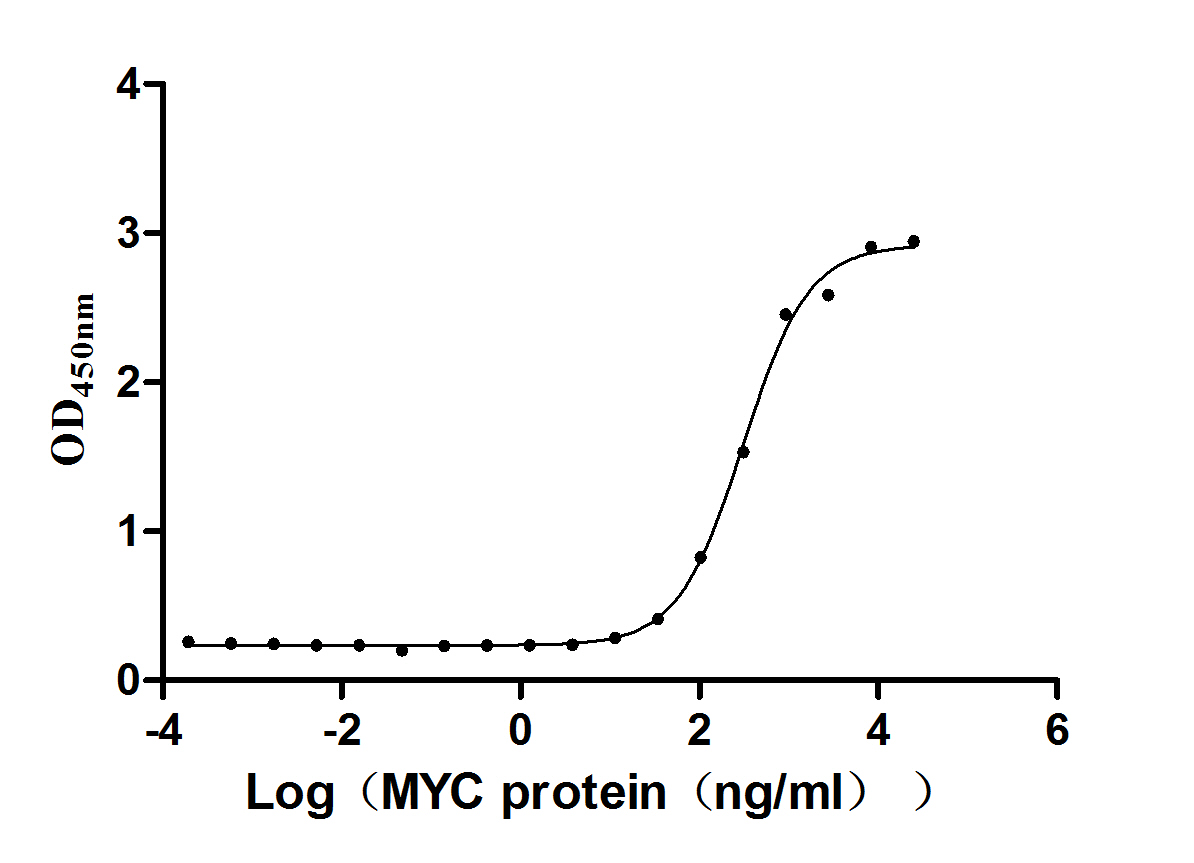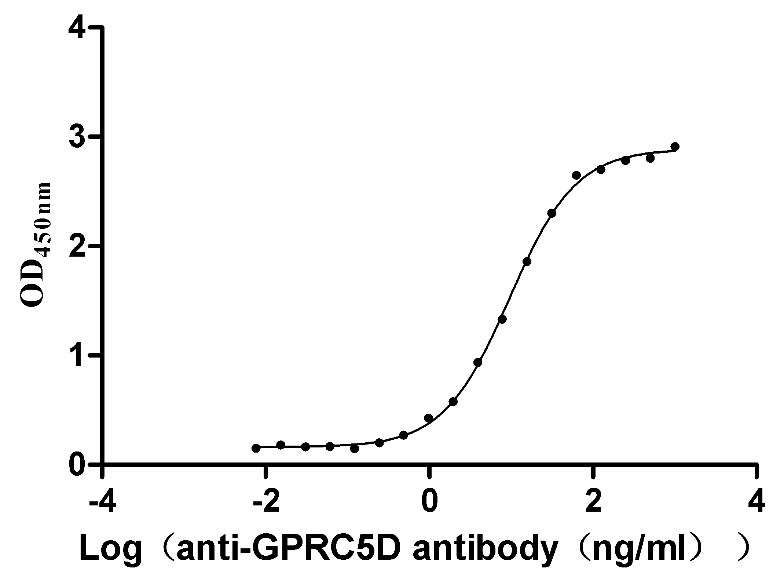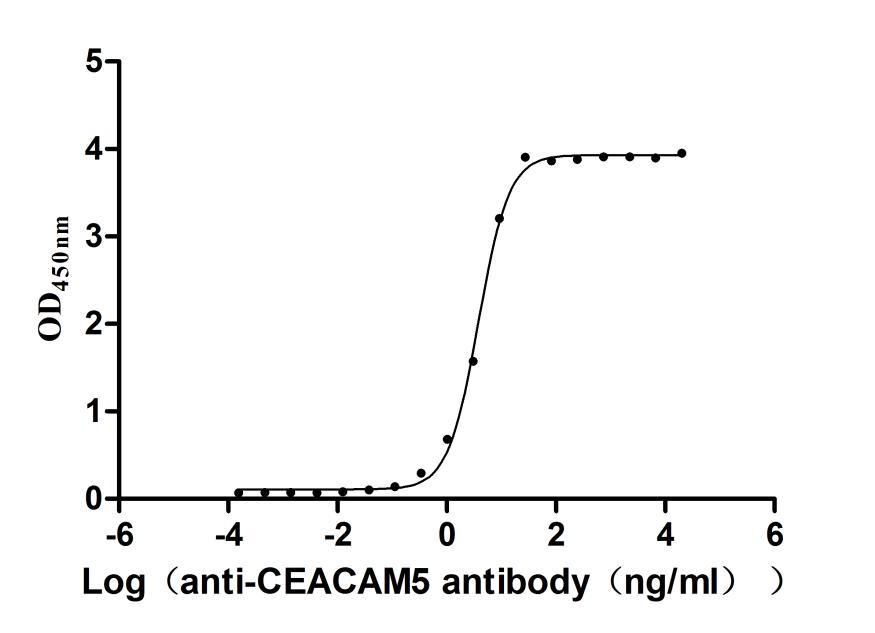Recombinant Mouse Homeobox protein SIX3 (Six3)
Unavailable-
货号:CSB-YP723456MO
-
规格:
-
来源:Yeast
-
其他:
-
货号:CSB-EP723456MO
-
规格:
-
来源:E.coli
-
其他:
-
货号:CSB-EP723456MO-B
-
规格:
-
来源:E.coli
-
共轭:Avi-tag Biotinylated
E. coli biotin ligase (BirA) is highly specific in covalently attaching biotin to the 15 amino acid AviTag peptide. This recombinant protein was biotinylated in vivo by AviTag-BirA technology, which method is BriA catalyzes amide linkage between the biotin and the specific lysine of the AviTag.
-
其他:
-
货号:CSB-BP723456MO
-
规格:
-
来源:Baculovirus
-
其他:
-
货号:CSB-MP723456MO
-
规格:
-
来源:Mammalian cell
-
其他:
产品详情
-
纯度:>85% (SDS-PAGE)
-
基因名:Six3
-
Uniprot No.:
-
别名:Six3; Homeobox protein SIX3; Sine oculis homeobox homolog 3
-
种属:Mus musculus (Mouse)
-
蛋白长度:full length protein
-
表达区域:1-333
-
氨基酸序列MVFRSPLDLY SSHFLLPNFA DSHHCSLLLA SSGGGSGASG GGGGAGGGGG GNRAGGGGAG GAGGGSGGGG SRAPPEELSM FQLPTLNFSP EQVASVCETL EETGDIERLG RFLWSLPVAP GACEAINKHE SILRARAVVA FHTGNFRDLY HILENHKFTK ESHGKLQAMW LEAHYQEAEK LRGRPLGPVD KYRVRKKFPL PRTIWDGEQK THCFKERTRS LLREWYLQDP YPNPSKKREL AQATGLTPTQ VGNWFKNRRQ RDRAAAAKNR LQHQAIGPSG MRSLAEPGCP THGSAESPST AASPTTSVSS LTERADTGTS ILSVTSSDSE CDV
-
蛋白标签:Tag type will be determined during the manufacturing process.
The tag type will be determined during production process. If you have specified tag type, please tell us and we will develop the specified tag preferentially. -
产品提供形式:Lyophilized powder
Note: We will preferentially ship the format that we have in stock, however, if you have any special requirement for the format, please remark your requirement when placing the order, we will prepare according to your demand. -
复溶:We recommend that this vial be briefly centrifuged prior to opening to bring the contents to the bottom. Please reconstitute protein in deionized sterile water to a concentration of 0.1-1.0 mg/mL.We recommend to add 5-50% of glycerol (final concentration) and aliquot for long-term storage at -20℃/-80℃. Our default final concentration of glycerol is 50%. Customers could use it as reference.
-
储存条件:Store at -20°C/-80°C upon receipt, aliquoting is necessary for mutiple use. Avoid repeated freeze-thaw cycles.
-
保质期:The shelf life is related to many factors, storage state, buffer ingredients, storage temperature and the stability of the protein itself.
Generally, the shelf life of liquid form is 6 months at -20°C/-80°C. The shelf life of lyophilized form is 12 months at -20°C/-80°C. -
货期:Delivery time may differ from different purchasing way or location, please kindly consult your local distributors for specific delivery time.Note: All of our proteins are default shipped with normal blue ice packs, if you request to ship with dry ice, please communicate with us in advance and extra fees will be charged.
-
注意事项:Repeated freezing and thawing is not recommended. Store working aliquots at 4°C for up to one week.
-
Datasheet :Please contact us to get it.
靶点详情
-
功能:Transcriptional regulator which can act as both a transcriptional repressor and activator by binding a ATTA homeodomain core recognition sequence on these target genes. During forebrain development represses WNT1 expression allowing zona limitans intrathalamica formation and thereby ensuring proper anterio-posterior patterning of the diencephalon and formation of the rostral diencephalon. Acts as a direct upstream activator of SHH expression in the rostral diencephalon ventral midline and that in turn SHH maintains its expression. In addition, Six3 activity is required for the formation of the telencephalon. During postnatal stages of brain development is necessary for ependymal cell maturation by promoting the maturation of radial glia into ependymal cells through regulation of neuroblast proliferation and migration. Acts on the proliferation and differentiation of neural progenitor cells through activating transcription of CCND1 AND CCND2. During early lens formation plays a role in lens induction and specification by activating directly PAX6 in the presumptive lens ectoderm. In turn PAX6 activates SIX3 resulting in activation of PDGFRA and CCND1 promoting cell proliferation. Also is required for the neuroretina development by directly suppressing WNT8B expression in the anterior neural plate territory. Its action during retina development and lens morphogenesis is TLE5 and TLE4-dependent manner. Furthermore, during eye development regulates several genes expression. Before and during early lens development represses the CRYGF promoter by binding a SIX repressor element. Directly activates RHO transcription, or cooperates with CRX or NRL. Six3 functions also in the formation of the proximodistal axis of the optic cup, and promotes the formation of optic vesicles-like structures. During pituitary development, acts in parallel or alternatively with HESX1 to control cell proliferation through Wnt/beta-catenin pathway. Plays a role in eye development by suppressing WNT1 expression and in dorsal-ventral patterning by repressing BMP signaling pathway.
-
基因功能参考文献:
- Six3 is haploinsufficient for main olfactory epithelium development, GnRH neuron migration, and fertility. PMID: 29589282
- SP8 and SP9 coordinately promote D2-type medium spiny neuron production by activating Six3 expression PMID: 29967281
- Six3 in a small population of progenitors expressing Six3-Cre at E8.5 is required for neuroretinal specification via regulating cell signaling and survival in mice. PMID: 28579317
- variations in Six3 dosage result in different forms of Holoprosencephaly PMID: 27770010
- SIX3 and SIX6 play distinct but compensatory roles in regulating transcription of gonadotrope-specific genes as gonadotrope cells differentiate. PMID: 25915183
- Sox2 directly activates the Six3 forebrain enhancer. PMID: 23792023
- Six3OS regulates Six3 activity in developing retina by a mechanism via which promoter-associated long non-coding RNAs can modulate the activity of their associated protein coding genes during development. PMID: 21936910
- It was shown that Six3 is necessary for ependymal cell maturation during postnatal stages of brain development. In its absence, ependymal cells fail to suppress radial glia characteristics. PMID: 22071110
- Neuroretina specification requires Six3-mediated suppression of Wnt8b a few hours later at the 6- to 8-somite stage. PMID: 20890044
- Six3-mediated auto repression and eye development requires its interaction with members of the Groucho-related family of co-repressors. PMID: 12050133
- role of expression with pax6 on haploinsufficient lens phenotype PMID: 12072567
- Six 3 and Six 6 are differentially required during forebrain development; gene expression in brain PMID: 15973738
- The Pax-Eya-Six-Dach network is at best only partly conserved during lens and nasal placode development. PMID: 16024294
- Six3 directly activates Pax6 and probably also Sox2 in the PLE and regulates cell autonomously the earliest stages of mammalian lens induction. PMID: 17066077
- role for the MTA1 as an upstream modifier of Six3 and indicate that Six3 is a direct stimulator of rhodopsin expression. PMID: 17666527
- At the 15- to 17-somite stage, the prospective diencephalon is the most-anterior structure in the Six3-null brain, and Wnt1 expression is anteriorly expanded. PMID: 18094027
- Six3-cre transgene is selectively expressed in layer 4 of sensory cortical areas. PMID: 18543315
- Haploinsufficiency of both Six3 and Hesx1 leads to severe pituitary dysmorphogenesis during development, which results in hypopituitarism with dramatic postnatal growth retardation. PMID: 18775421
- These data suggest a direct link between Six3 and Shh regulation during normal forebrain development and in the pathogenesis of holoprosencephaly. PMID: 18836447
显示更多
收起更多
-
亚细胞定位:Nucleus.
-
蛋白家族:SIX/Sine oculis homeobox family
-
组织特异性:Expressed in ependymal cells during the formation of the lateral wall.
-
数据库链接:
KEGG: mmu:20473
STRING: 10090.ENSMUSP00000135677
UniGene: Mm.370208
Most popular with customers
-
Recombinant Human papillomavirus type 16 Protein E7 (E7) (Active)
Express system: E.coli
Species: Human papillomavirus type 16
-
Recombinant Human G-protein coupled receptor family C group 5 member D (GPRC5D)-VLPs (Active)
Express system: Mammalian cell
Species: Homo sapiens (Human)
-
Recombinant Human Interleukin-17A (IL17A) (T26A) (Active)
Express system: Baculovirus
Species: Homo sapiens (Human)
-
Recombinant Human Cadherin-17 (CDH17), partial (Active)
Express system: Mammalian cell
Species: Homo sapiens (Human)
-
Recombinant Rat Gastric inhibitory polypeptide receptor (Gipr), partial (Active)
Express system: Mammalian cell
Species: Rattus norvegicus (Rat)
-
Recombinant Human Myosin regulatory light chain 12B(MYL12B) (Active)
Express system: E.coli
Species: Homo sapiens (Human)
-
Express system: Mammalian cell
Species: Macaca mulatta (Rhesus macaque)
-
Recombinant Human Tumor necrosis factor ligand superfamily member 15(TNFSF15) (Active)
Express system: Mammalian cell
Species: Homo sapiens (Human)




-AC1.jpg)




-AC1.jpg)










